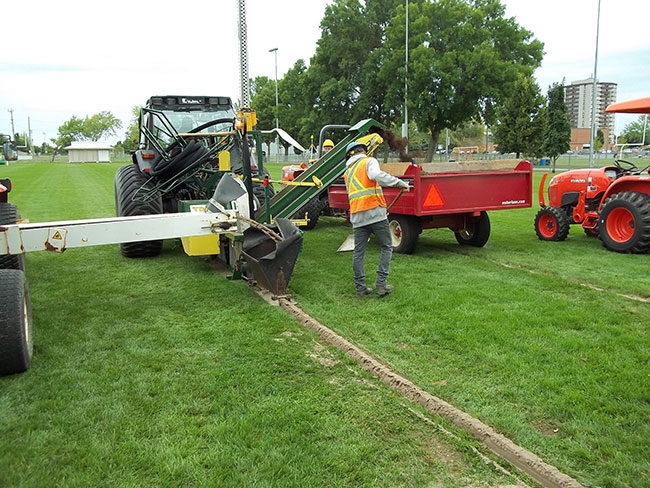
News
Sports turf
Turf Care Equipment
Slit drainage helps keep fields in play
Sports fields equipped with slit drainage see fewer cancellations, better field playability.
December 11, 2018 By Mike Jiggens
 A demonstration of slit drainage was conducted at Sports Turf Canada’s annual field day in Belleville, Ont.
A demonstration of slit drainage was conducted at Sports Turf Canada’s annual field day in Belleville, Ont. The evacuation of water on a sports field is that much faster when it has been prepared with slit drainage. This leads to fewer cancellations, better field playability and less wear.
John Van Roestel of TDS Turf Drainage Systems Ltd. explained the concept of slit drainage and its benefits to those attending September’s Sports Turf Canada Ontario Field Day in Belleville.
The difference between slit drainage and conventional drainage, he said, is that slit drainage gets rid of the native soil and backfills the trenches with coarse sand, allowing water to percolate faster. The shallower drains are put in on the grade using precision laser guidance.
Van Roestel has been installing drainage systems in sports fields and on golf courses for 20 years.
Two-inch perforated pipe is put into the ground at a depth of 12 inches in a simultaneous operation with the removal of the native soil and backfilling with sand. Slit drainage is designed to eliminate surface water that much faster while conventional drainage takes the water longer to move down following a significant rain event.
“This allows that to happen quicker,” he said.
Slit drains are usually spaced between six and 12 feet apart on sports fields. The installation machine is laser controlled, allowing for a one-pass operation. A sand buggy runs alongside the machine, filling in the trenches with sand. Another truck runs alongside to collect the native soil while a packer packs the sand.
On sports fields, drains are put in parallel to the irrigation lines. Because the depth is only 12 to 14 inches, the work remains atop the irrigation lines. Slit trenches collect excess water as it moves across the surface, channeling the water to collectors and finally to an outlet. Drains should run across the ground perpendicular to the direction of the runoff water.
For an average sports field with 10 feet of spacing, about 6,000 feet of drain is put in, or about 20 lines of about 300 feet in length.
On sports fields crowned about one per cent on top, drain lines should run parallel to the crowns. On a crowned field, rain will run toward the sides of the field.
When installing slit drainage on golf greens, the sod is removed first before the system is installed. The removed sod is then put back in place. On sports fields, straight sand of about three millimetres in size is put back in to allow water to percolate through at about 30 to 40 inches an hour.
“That’s what we’re looking for. With greens, that’s a little too fast and it will get a little too droughty.”
Greens are usually a 60-20-20 mix, respectively of sand, topsoil and peat or are a 60-40 sand-soil mix.
The possibility of trench lines caving in on sand-based fields is usually not an issue, Van Roestel said. It’s a one-pass operation, but he said if the trenches were left alone for any time “you could have issues. We’ve modified everything so that we can do this in one pass.”
The recovery time for the field begins about a week after the drainage has been installed, “and that grass starts creeping across and it’s down to about two inches (width of the line). After about three weeks, it’s down to about an inch wide. After four weeks, it’s pretty much grassed over.”
Sodding over the drain lines is not recommended. Allowing the turf to re-establish itself atop the sand will help water move through faster than it would move through layered sod. When sand is used, a filter-wrapped pipe will help prevent clogging, but the technique is not recommended if stone is to be used as a backfill.
In a golf course application, slit drainage is especially effective on older pushup greens that have little or no subsurface drainage and have heavy native topsoil that is easily compacted, resulting in surface pooling. Slit drainage allows the excess water to escape before it can freeze and cause ice damage.
Slit drainage on golf greens also allows for more uniform watering in situations where high areas had drained well while lower areas didn’t.
Print this page